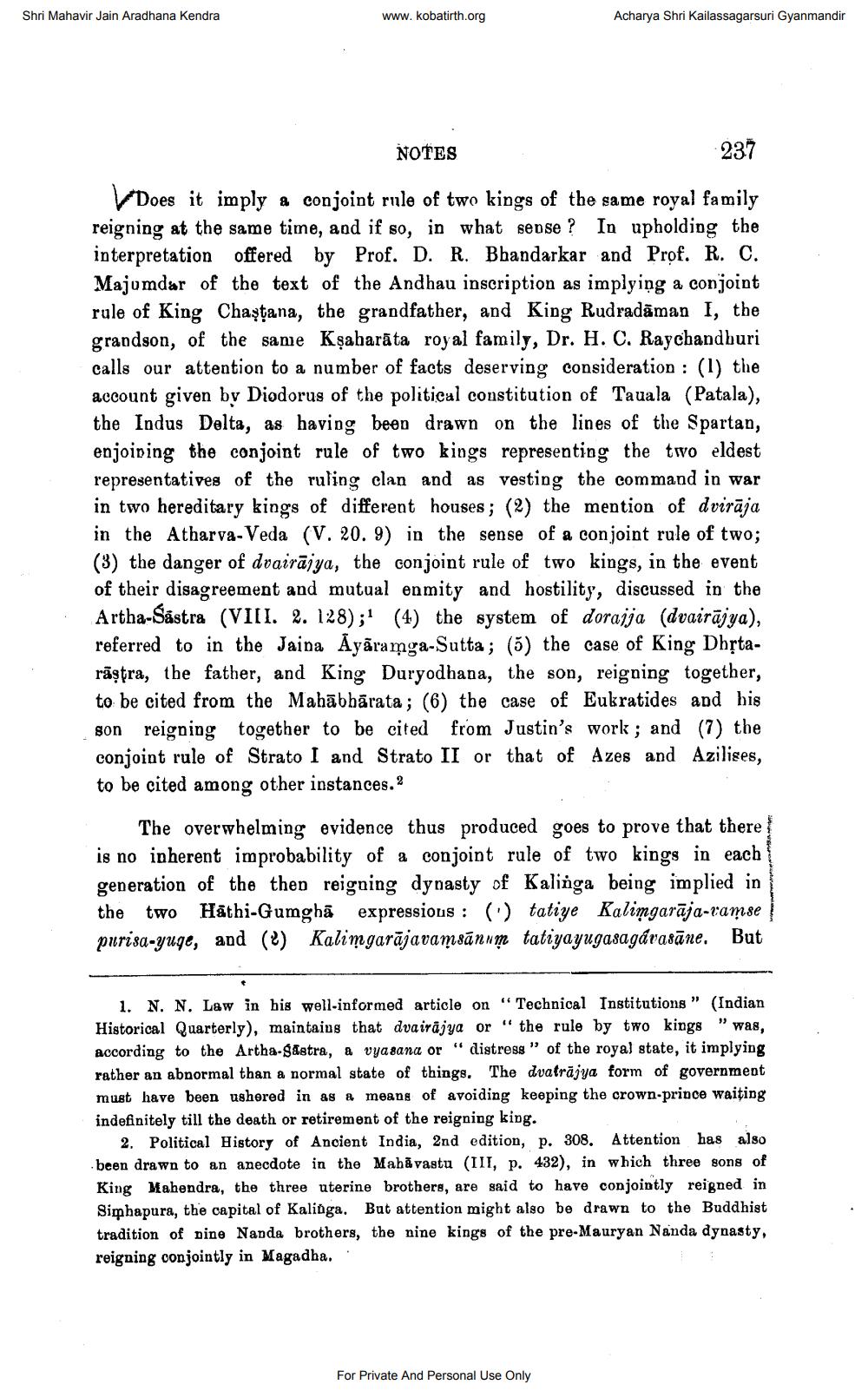________________
Shri Mahavir Jain Aradhana Kendra
www.kobatirth.org
Acharya Shri Kailassagarsuri Gyanmandir
NOTES
237
Does it imply a conjoint rule of two kings of the same royal family reigning at the same time, and if so, in what sepse? In upholding the interpretation offered by Prof. D. R. Bhandarkar and Prof. R. C. Majumdar of the text of the Andhau inscription as implying a conjoint rule of King Chaştana, the grandfather, and King Rudradāman I, the grandson, of the same Kşaharāta royal family, Dr. H. C. Raychandhuri calls our attention to a number of facts deserving consideration : (1) the account given by Diodorus of the political constitution of Tauala (Patala), the Indus Delta, as having been drawn on the lines of the Spartan, enjoining the conjoint rule of two kings representing the two eldest representatives of the ruling clan and as vesting the command in war in two hereditary kings of different houses; (2) the mention of dvirāja in the Atharva-Veda (V. 20. 9) in the sense of a conjoint rule of two; (3) the danger of dvairājya, the conjoint rule of two kings, in the event of their disagreement and mutual enmity and hostility, discussed in Artha-Sastra (VIII. 2. 128);' (4) the system of dorajja (dvairājya), referred to in the Jaina Ayāramya-Sutta ; (5) the case of King Dhrtarāstra, the father, and King Duryodhana, the son, reigning together, to be cited from the Mahābhārata; (6) the case of Eukratides and his son reigning together to be cited from Justin's work ; and (7) tbe conjoint rule of Strato I and Strato II or that of Azes and Azilises, to be cited among other instances. 2
The overwhelming evidence thus produced goes to prove that there is no inherent improbability of a conjoint rule of two kings in each generation of the then reigning dynasty of Kalinga being implied in the two Hathi-Gumghā expressions : (') tatiye Kalimgarāja-ramse purisa-yuge, and (2) Kalimgarājavamsānnm tatiyayugasagåvasāne. But
1. N. N. Law in his well-informed article on “Technical Institutions” (Indian Historical Quarterly), maintains that dvairājya or “ the rule by two kings " was, according to the Artha-gåetra, a vyasana or " distress" of the royal state, it implying rather an abnormal than a normal state of things. The dvatrājya form of government must have been ushered in as a means of avoiding keeping the crown-prince waiting indefinitely till the death or retirement of the reigning king.
2. Political History of Ancient India, 2nd edition, p. 308. Attention has also been drawn to an anecdote in the Mahāvastu (III, p. 432), in which three sons of King Mahendra, the three uterine brothers, are said to have conjointly reigned in Simhapura, the capital of Kalinga. But attention might also be drawn to the Buddhist tradition of pine Nanda brothers, the nine kings of the pre-Mauryan Nanda dynasty, reigning conjointly in Magadha..
For Private And Personal Use Only




